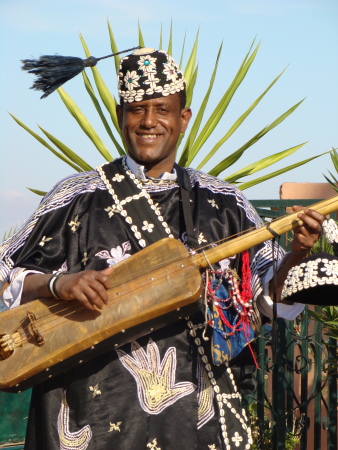
Marrakech, not far from the Jewish Quarter: We'd been admiring the architecture and the gorgeous Islamic tilework of Marrakech's better palaces and were pausing for lunch at the rooftop garden restaurant on the top of one of them.
Climbing the slow, arching stairways of the old palace, we spiralled past the kitchen on the 3rd floor before reaching the restaurant serving Marrakechi specialties. The welcoming smells of steaming couscous, sweet prunes, and grilling meats fully filled the upper half of the old building. We chose a table in the shade of a potted orange tree and tucked into dishes of steaming tajines, and ordered a glass of fresh fruit juice each.
That's when the troubadour appeared.
Continue reading "The Troubadour"
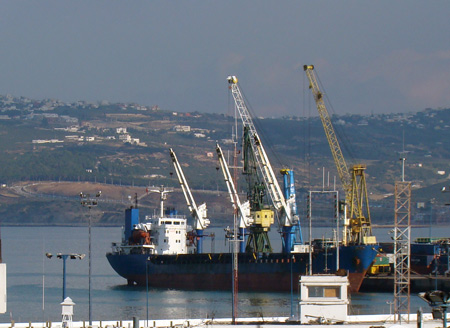
New Year's Eve, 2007 finds us at the gateway to North Africa: Tangier, Morocco. A sin-city only a generation ago, Tangier is now poised between the charm of yesteryear and the promise of modernity. Elsewhere in Morocco it was hard not to be conscious of the events of centuries before, but Tangier's heyday was in the late 19th and 20th centuries, and we wandered the narrow streets mindful not of ancient sultans but of the Beat Generation's Usual Suspects.
Continue reading "Year End at Land's End:Tangier"
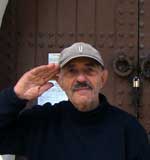
The best memories of travel are of the people we meet along the way. This is, after all, why we travel: because we learn as much about ourselves as we do about others, but what we learn about ourselves we learn through others' eyes. In that spirit, one of my fondest memories of Tangier will be of Mustapha Cherqui, the caretaker of St. Andrew's Church.
Continue reading "St. Andrew's Caretaker"
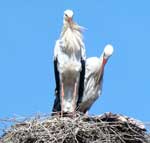
Touring Morocco means spending long hours looking up, because the Islamic architects that crafted Morocco's most dramatic cities carried their talents high up into the sky in the form of splendid minarets. In fact, were looking up not so dangerous - it seems like every time I lifted my head I narrowly escaped being run over by a donkey bearing goods down the cities' narrow streets - I would have spent more time admiring the delicate craftsmanship that makes Moroccan cities such a pleasure to experience.
We started with Morocco's newest but most starkly dramatic minaret, the Mosque Hassan II, at 200 meters, the tallest minaret in the world. After visiting so many gorgeous cathedrals and monuments throughout Europe, all of which date from another era, it was amazing to tour a structure that was built during my lifetime (in fact, since I graduated from university) and will some day, centuries from now, be an "old" monument for tourists of another generation to gape at.
Continue reading "The Tower Builders"
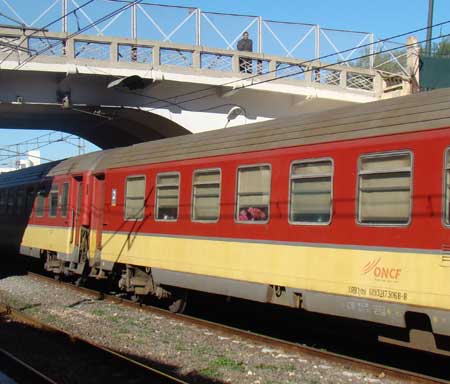
The train station in Meknes reminded me a bit of the station in Cefalu, Sicily: a clean and modern structure rife with architectural touches peculiar to the local culture, set alongside two pairs of rails that went sweeping around the bend to adventure in each direction. Even the trains are similar: compartmentalized cabins with side corridors, official vendors pushing wheeled snack carts, and outside the window, endless olive fields and hedge rows. Traveling by train in Morocco is pleasant and easy, and provided you can get a seat in one of the overfull 2nd class compartments, quite comfortable.
We were fortunate to squeeze into a compartment then, because the train had begun in Fes, and was already nearly full when it pulled up to Meknes with a screech. We found seats in an 8 person compartment with 6 others traveling north from Fes, and settled in for the long ride to Tangier along the coast.
Continue reading "The Train to Tangier"
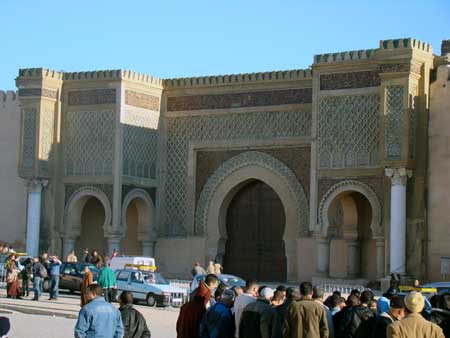
Tea in Meknes with
Two cubes of sugar,
Sunlight fading against the
Old city wall.
Continue reading "Tea in Meknes"
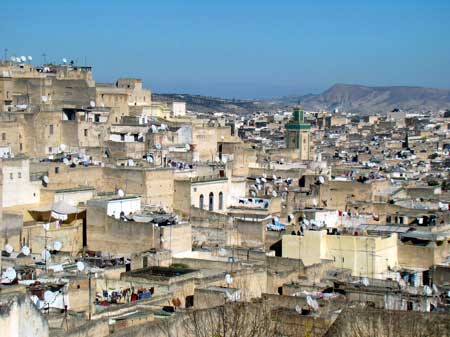
The year is 1248: North Africa has been Islamicized for six centuries and Fes has grown under Sultan Idriss II to become a center of learning unparalleled across the Eastern hemisphere, and a place of spiritual importance third only to Mecca and Medina. Meanwhile, across the Mediterranean, Europe lies so profoundly entrenched in the religious dogma of the Dark Ages that science and mathematics are regarded as practically akin to sorcery and devil-worship. It is, for the moment, the Islamic world that holds the key to learning and the avancement of civilization: even Pope Sylvester II has traveled to Fes to study, and the Andalusian architects, mathematicians, and planners who have come to participate in the society now run by the Merenids (the last of Morocco's Berber empires) are building one of medieval Islam's most impressive cities.
But it is equally a moment of transition: Portuguese sea power is growing and European explorers are slowly gaining courage as they sail south of Cape Boujadour, hoping to expand the trade routes that for the moment pass through the Sahara. Mercantalism is winning over religious edict. Before long Spain's Ferdinand and Isabella will drive the Moors from Al Andalus in the south of Spain, and the balance of power will shift to the West. But for now, the Merenid empire, and its capital at Fes, are on the ascent.den bins of clementines, flat breads, and dates, stunning zellij tilework and calligraphy.
Continue reading "The Footsteps of the Merenids: Fes"
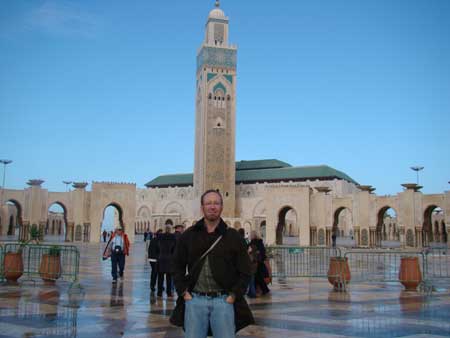
Every religion has its share of extremists, but they are fortunately, and for the moment, the exception to the rule. And to its profound credit, one way Morocco really impressed me was with its example of moderate Islam. I can't claim to be an expert on the subject, although I did live from 93 to 94 in Indonesia, another moderate Muslim country (neither of which, unfortunately, is free from extremism, notably the Kuta Beach bombing of October 2002 and the 9/11 hijackers in 2001). But Morocco impressed me with the way Islam shapes the nation's cultural imprint without being overwhelming, and the way Moroccans seem to embrace Islam without tending toward extremism. Often I found myself thinking, "if this is what Islam is like, the world needs more of it."
Continue reading "A Prayer for Moderation: Islam in Morocco"
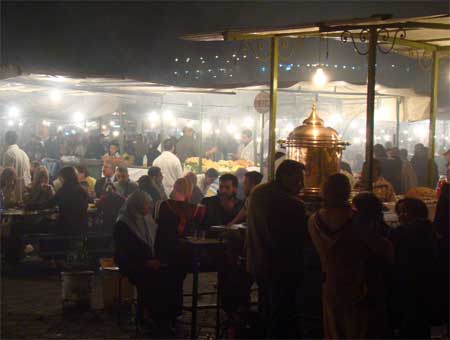
Evenings in Marrakesh, after browsing the shop windows of the jewellers and cobblers we liked to settle down to eat in the outstanding Djemaa el Fna, which our guidebook called "the finest city square in the world." And it was indeed pretty wonderful: acrobats, story tellers, snake charmers, and row after row of brightly-lit foodstalls.
It was the best place on earth to eat. Around the edge of the square were the restaurants serving warm couscous and stewed meats, and the ubiquitous sidewalk cafes serving mint tea and steaming black coffee. But across the rest of the square every stall was a new delight: heaps of walnuts, almonds, and salted cashews, dried apricots, fresh prunes, figs, and dates.
Continue reading "Simple Pleasures: The Evening Meal in Djemaa el Fna"
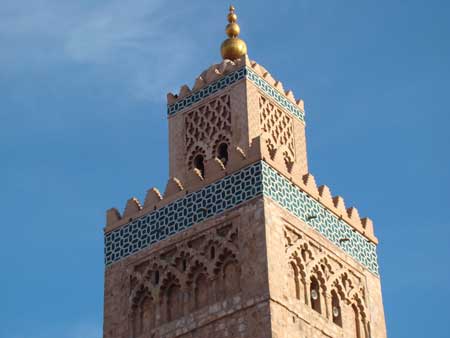
Marrekesh is simply uncapturable: like Venice, Borobudur, or perhaps Machu Pichu, a photograph of Marrakesh encompasses too narrow a field, words are too prosaic to really evoke a sense of the place, and both video and audio record just a slice of the experience. Marrakesh is all of these things, and more, but it's the totality that makes it such an experience for the senses.
Better then to experience it, instead of trying to capture it. But where to begin? For us it was in the dark, winding alleyways of the marvelous souks: markets of spices, carpets, leatherwork, punched tin lanterns and colored glass, backgammon boards of inlaid wood, tall candles, and traditional Moroccan slippers. But we explored around the old medina's edges and the magisterial city wall as well, where we enjoyed the carefully tended rose gardens growing at the base of the Koutubia Mosque ("the most perfect minaret in North Africa"), the storks' nests on the crenelated city walls, and the phenomenal tilework of the Bahia Palace. And evenings, after browsing the shop windows of the jewelers and cobblers we settled down for warm soup and kebabs in the outstanding Djemaa el Fna, which our guidebook called "the finest city square in the world."
Continue reading "Marrakesh"










